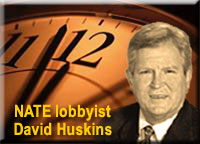|
NATE's rescue changes disregarded as North Carolina fall protection standard becomes law
September 8, 2005 - The good news, as the North Carolina Department of Labor sees it, is that the state's hotly contested Fall Protection Standard went  into effect last Friday; the good news, as the National Association of Tower Erectors sees it, is that two key safety requirements may be revised next May. If there's bad news it rests upon the shoulders of tower service companies who will be struggling with manpower resources to ensure that they can provide the rescue requirements the standard calls for regarding employee training. into effect last Friday; the good news, as the National Association of Tower Erectors sees it, is that two key safety requirements may be revised next May. If there's bad news it rests upon the shoulders of tower service companies who will be struggling with manpower resources to ensure that they can provide the rescue requirements the standard calls for regarding employee training.
The standard, which has become a Who's on First? legislative effort between a bureaucracy and business leaders, became law September 2 when the General Assembly adjourned without acting upon a Technical Corrections Bill before the House that contained an amendment that would have been beneficial to tower service companies.
Standard in effect now
The standard in effect this week requires employers to ensure that at least two trained and designated rescue employees are on site when employees are working at heights over six feet on the tower, provided however, where there are only two employees on site, then an employer may comply with the requirements if one employee is a trained and designated rescue employee and one employee has been designated by the employer as a probationary employee and has been employed for less than six months. NATE had been forceful in their belief that 12 months would better serve the industry.
Another section of the standard that took effect September 2 allows a company to designate a third party rescue and emergency service to provide high angle rescue; however, it requires the employer to evaluate the prospective rescue team's ability to respond as well as identify if they are proficient with rescue-related tasks. NATE believed that it should be the responsibility of the rescue firm to provide verification that they were proficient in high angle rescue.
On August 22 after about a half-hour debate before the State Senate Judiciary Committee on the revisions for changing the rescue training time frame from six months to 12 months and new language requiring "verification versus evaluation" of third party rescue companies, Sen. David Hoyle, D-Gaston County, moved for a substitute amendment on the training time-frame that allowed for "nine months" instead of six months. The motion carried on a voice vote. The language on third party rescue remained as re-written in the PCS under consideration. NATE Lobbyist David Huskins gave testimony on behalf of NATE, while Chief Counsel John Hoomani represented the N.C. Department of Labor.
These two changes were included in a Technical Corrections Bill that contained other legislative amendments. The bill passed the full Senate two days later and was sent to the House for concurrence.
However, the House adjourned on September 2 without voting on the Senate bill, and the fall protection standard, by law, became effective immediately without the changes.
The House will convene on May 9, 2006 and is expected to take up the Technical Corrections Bill again. If the House concurs or some form of the Bill passes out of both chambers, the second employee would not have to have rescue training if he has been with the company less than nine months, and the onus to identify that a third party rescue firm is qualified would be with the safety company, not the tower service employer. But then again, Governor Mike Easley could veto the Bill. The outcome is anybody's bet in the state where the Governor last week signed legislation creating a state lottery.
The full text of the changes of the fall protection standard that might be considered for approval next May are:
SECTION 102.(a) The Department of Labor shall adopt rules in connection with its requirements regarding fall protection for tower climbers as follows:
(1) With regard to employer-provided rescue procedures, employers must ensure that at least two trained and designated rescue employees are on site when employees are working at heights over six feet on the tower, except that where only two employees are on site, then an employer may comply with this requirement if one employee is a trained and designated rescue employee and one employee has been employed for less than nine months and has received documented orientation from the employer outlining steps to take in an emergency.
(2) With regard to third-party-provided rescue procedures, the employer must obtain verification from the third-party rescue service that the service is able to respond to a rescue summons in a timely manner and that the service is proficient in rescue-related tasks and equipment needed to rescue climbers from elevated heights on communication structures. The employer must also provide the selected third-party rescue service with contact information regarding the tower site and allow the service to conduct whatever preparation for rescue it deems necessary.
Copyright © Wireless Estimator, Inc. Please request reprint permission.
|